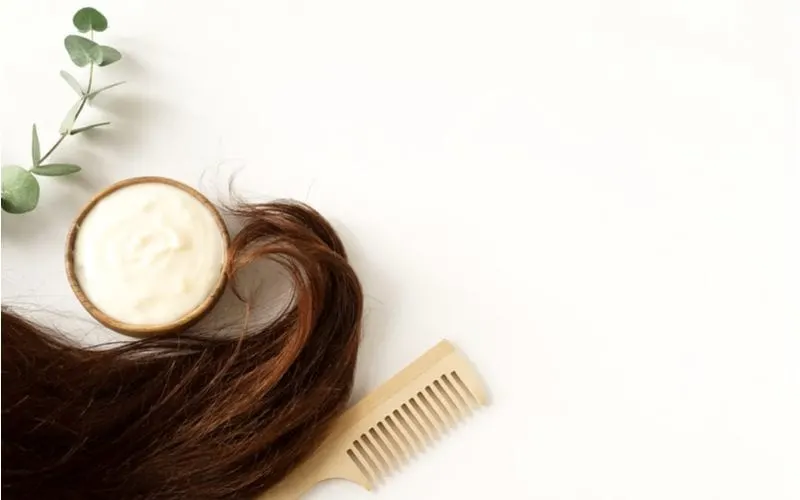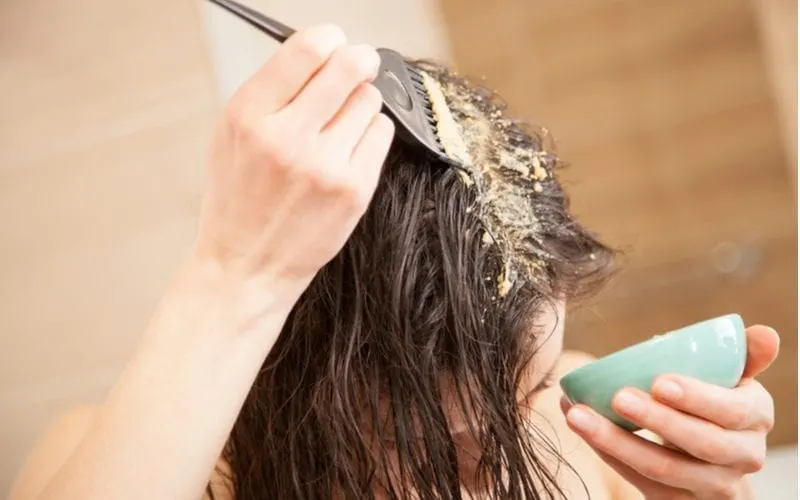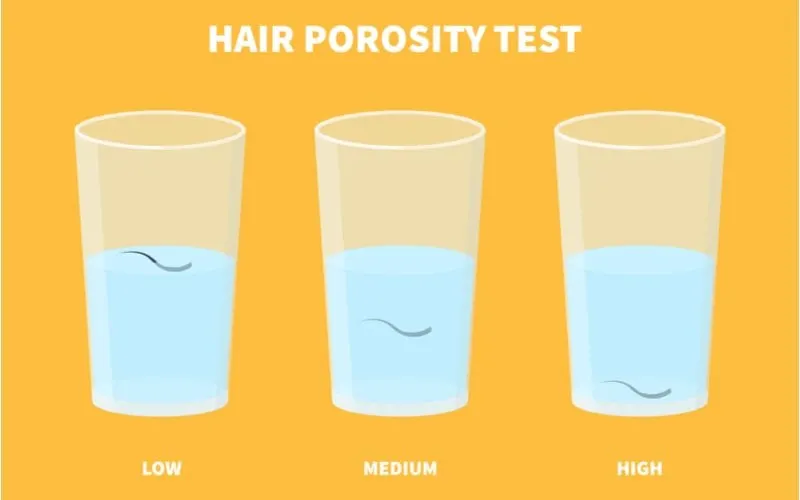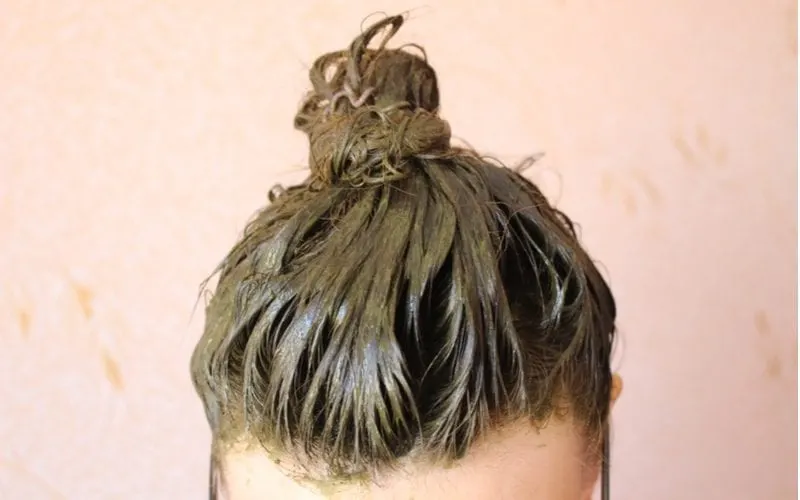Jump to:
They can make your locks look and feel amazing, but how often should you do a hair mask? Well, it depends. Take a peep at our guide to see hair masking recommendations for every hair type.
How Often Should You Do a Hair Mask?

IrenaStar/Shutterstock
Hair masks are my favorite hair care ritual. There’s something utterly soothing and satisfying about applying these nourishing, damage-repairing, moisturizing treatments to your hair.
You can feel the hydration and nutrients sinking deep into your strands when you use one. But the best part is how your hair looks and feels dramatically healthier, shinier, and softer after using one.
If you’ve found a hair mask you love using, you know what I mean. The difference from before to after can be like night and day. If you’re anything like me, you like the results so much that you’ve probably considered bumping up your hair mask frequency.
You might be asking:
- Since using it once a week gives you such amazing results, wouldn’t using it 2-3 times a week double or triple the effectiveness?
- Would it be crazy to start using a hair mask every day?
- How often should you do a hair mask for the best results?
Well, it’s not quite that simple. So I decided to dive deep into the topic with some research to find out how often hair masks should be used for the optimal results.
The Short Answer:
| Hair Type | Moisturizing Mask | Protein-Based Mask |
|---|---|---|
| Damaged | 2-3 times per week | 2-4 times per month |
| Coily/Curly | 2-3 times per week | 1-2 times per month |
| Dry | 2-3 times a week | Not recommended |
| Oily | Once per week | 1-2 times per month |
| Fine | Once per week | 1-4 times per month |
| Dense/Thick | 1-3 times per week | 1-4 times per month |
The Long Answer:
Like many treatments, I found that overdoing it won’t necessarily improve your results. For some hair types, using a hair mask too often can actually reduce the effectiveness of the mask and make hair greasy, weighed down, or overloaded with protein.
On the other hand, doing hair masks too infrequently might give you little boosts in shine and softness when you do use them, but won’t have the long-term hair health effects you’re hoping for.
In this guide, you’ll see the best hair mask recommendations for every hair type. We’ll tell you what type to look for and note how often your hair type should use a hair mask for the optimal results. First, let’s look at the kind of mask your hair type should use.
Read Next:
What Type of Hair Mask Should You Use?

Maryna Pleshkun/Shutterstock
There are thousands of hair mask options out there, but in general, there are only 2 types: Pure moisture masks and protein-based masks.
Moisturizing hair masks give hair a luxurious dose of hydration and moisture. They’re like a conditioner on steroids. They restore and define waves and curls, deliver even moisture from the roots down to the ends, and ensure soft, manageable results.
These have a little more room for error – you don’t need to use a specific amount, and if you have coarse or curly hair, you can use them more often than the label recommends.
Those with fine hair should be cautious using moisturizing hair masks more than once a week because they can easily weigh the hair down with buildup.
Use a moisture-based hair mask if your hair is:
- Medium to coarse in texture
- Wavy or curly
- Frizzy
- Rough to the touch
- Brittle or dry
Protein-based hair masks include one or more sources of protein for hair. They are typically labeled as strengthening or damage repair masks. Protein hair masks can act as a “filler” for weak or damaged hair to help with damage, breakage, and shedding.
Since they contain protein, which can cause issues for low-porosity hair, there’s less room for error with these hair masks. Overuse of a protein hair mask can cause protein overload, where too much protein collects on strands and makes them brittle, hard, and easily broken.
Use a protein-based hair mask if your hair is:
- Fine in texture
- Medium or high porosity
- Chemically processed
- Damaged
- Weakened and easily broken
Know Your Hair’s Porosity

Art4stock/Shutterstock
In order to determine if using a protein-based hair mask will work for your hair, you need to know how porous it is. Your hair’s porosity is how “open” your strands are to allowing moisture in and out.
Low porosity hair isn’t very porous or absorbent. It has closely spaced cuticle cells in the outer layer of the strands, so it holds onto the moisture inside without letting much in or out.
When protein hair masks are applied to low porosity hair, it isn’t absorbed well by the strands and tends to build up and create protein overload.
High porosity hair has wider spacing between cuticle cells and is much more porous and absorbent. When you apply a protein hair mask to high porosity hair, most of it is absorbed into the hair as intended.
Hair with low porosity is much easier to overload with protein than high porosity hair. To find out how porous your hair is with this simple test:
Fill a glass with clean water, then add a single strand of your clean, product-free hair to the water.
- If it sinks immediately, you have high porosity hair and can use a protein hair mask without issues.
- If it floats near the middle, you have normal or medium porosity hair. Limited use of a protein hair mask in conjunction with moisturizing hair masks won’t harm your hair.
- If it floats on top for a bit before sinking, you have low porosity hair. You should avoid using a protein hair mask and opt for a moisturizing mask instead.
Drying time is another easy way to determine how porous your hair is. Hair that is overly porous sucks up water super fast. Hair with low porosity, on the other hand, is not very absorbent and likes to repel water. When it does get saturated, however, it doesn’t like to give it up easily.
If your freshly shampooed hair feels heavy and waterlogged but tends to air dry before you even finish your makeup, you likely have extremely porous hair. If it takes a great deal of blow drying to dry your hair, you have low porosity. For most of us, our hair will fall somewhere between these two extremes.
Now that you know the difference between the 2 general types of hair masks and which one you should use, let’s find out the answer to the burning question. How often should you do a hair mask to get the best results?
How Often Should You Do a Hair Mask On…
So, how often should you do a hair mask on each hair type? Damaged, curly, coily, dry, oily, fine, and thick hair all have different hair mask needs.
Many hair types can withstand frequent moisturizing hair masks more than once a week. But not many hair types can handle protein hair masks more than once a week or every other week.
Find your hair type below to see our recommendations on how often you should apply each type of hair mask.
Damaged Hair
- Moisturizing hair mask: 2-3 times a week
- Protein-based hair mask: 2-4 times a month
Damaged hair needs all the TLC it can get. If you’ve been going overboard with the bleach, swimming in chlorinated water, or styling without a heat protectant, you’re going to need some moisture and damage-repairing nutrients more often.
You can safely use a moisture-based hair mask 2-3 times a week on damaged hair. If you’re opting for a damage-repairing protein hair mask, you can use it once a week for the first month.
Then, drop your usage down to once every other week to maintain the results. Any more than that and you risk protein overload. This is when so much protein coats your hair that it becomes hard and brittle.
Curly or Coily Hair
- Moisturizing hair mask: 2-3 times a week, or when you wash
- Protein-based hair mask: 1-2 times a month
Curly and coily hair tends to have either a medium or coarse hair texture. These strand thicknesses can easily handle the intense hydration that moisture-based hair masks provide.
It’s hard to over-moisturize curly and coily hair! You can safely use a moisture-based hair mask 2-3 times a week on curly or coily hair. You can use one every time you wash your hair. Some curly/coily women successfully use moisturizing hair masks as a substitute for conditioner.
If you’re using a protein-based hair mask, you can safely use it anywhere from once a month (for low and medium porosity hair) to twice a month (for high porosity hair). Don’t use it more often than that to avoid overloading strands with protein.
Dry Hair
- Moisturizing hair mask: 2-3 times a week, or when you wash
- Protein-based hair mask: Not recommende
Chronically dry hair is a pain to deal with. It feels rough to the touch (even straw-like in some instances), has lots of split ends and flyaways, and may be accompanied by an itchy, flaky scalp.
Moisture-based masks are the best solution for chronically dry hair, and fortunately, you can use them as often as you need to restore the hair’s moisture. You can safely use a moisture-based mask 2-3 times a week, or anytime you wash your hair.
If you suspect that your hair is feeling dry due to a protein overload from other products you use (shampoo, conditioner, or treatments), do not use a protein-based hair mask. It will only worsen the problem. Stick to providing lots of nourishing moisture instead.
Oily Hair
- Moisturizing hair mask: Once a week or every other week
- Protein-based hair mask: 1-2 times a month
It might seem backward to use a moisture-based hair mask on hair that tends to get oily fast, but don’t discount it entirely. When your oily-prone scalp is stripped of its natural oils with shampoo, it freaks out and produces more oil in response.
It’s a vicious cycle: Your hair gets oily because you stripped the natural sebum, so you shampoo again, which strips the hair and continues the cycle. The only way to interrupt that cycle is by using a gentler shampoo (here’s the best shampoo for oily hair) and introducing moisture after shampooing.
That keeps your scalp from getting the cue to overproduce oil. Use a moisturizing hair mask once every week or every other week to provide enough moisture to keep oil under control.
If your hair tends to get oily fast and is damaged or weak, you can also use a protein hair mask one or two times a month to act as a filler and repair that damage.
Fine Hair
- Moisturizing hair mask: Once a week or every other week
- Protein-based hair mask: 1-4 times a month
Fine hair refers to the thickness of individual strands, not the overall scalp coverage or density of the hair. Fine hair has the smallest circumference of any hair texture and usually doesn’t contain the medulla, or the innermost structure of the hair.
It is easily weighed down by too much moisture, so if you’re planning to use a moisture-based hair mask, stick to using it once a week or once every other week.
Fine hair benefits the most from a protein-based hair mask that fills in gaps in the hair structure and helps it get stronger while appearing thicker. If you have low-porosity fine hair, you may be able to use a protein hair mask every other week or once a month.
If you have medium to high-porosity fine hair, use a protein hair mask once a week for 1 month to get the best results. After the first month, drop your usage to every other week to avoid protein overload.
Dense, Thick Hair
- Moisturizing hair mask: 1-3 times a week
- Protein-based hair mask: 1-4 times a month
When we say “thick hair,” what we really mean is dense hair with heavy scalp coverage. Your individual strands might be fine, medium, or coarse, but one thing is for sure…
You’ve got a lot of hair!
You should pay attention to the texture of your individual strands to find the best recommendations for hair mask frequency.
Here are the best practices for using a moisturizing hair mask on thick hair.
- Fine, thick hair should stick to once a week or once every other week.
- Medium thick hair should aim to use a moisturizing mask once or twice a week.
- Coarse thick hair can handle 3 or more applications each week.
For protein-based hair masks, consider the porosity of your hair for the best recommendations.
- Low porosity thick hair can use a protein-based hair mask as little as once a month to as frequent as once every other week.
- Medium porosity thick hair can use a protein mask every other week.
- High porosity thick hair can get away with using these masks as often as once a week.
So, How Often Should You Do a Hair Mask?

Anatoly Foto/Shutterstock
How often you should use a hair mask depends mainly on 4 things:
- The current condition of your hair (dry, damaged, oily, etc.)
- Your hair texture and type (fine, curly, coily, dense, etc.)
- Your hair’s porosity (low, medium/normal, or high)
- What you want the mask to do (moisturize, strengthen, repair, etc.)
In general, you should use a moisturizing hair mask if your hair is chronically dry, oily, medium or coarse-textured, or damaged in any way. A moisturizing hair mask can be used once every other week if you don’t want to overwhelm strands with hydration and weigh them down.
They can be used as often as 3 or more times a week if your hair is coarse or extremely thirsty. You should use a protein-based hair mask if your hair is fine-textured, weak, easily broken, medium to high porosity, or damaged through chemical processing.
Protein masks aren’t meant to be used as often as their moisturizing counterparts because protein easily builds up on the hair. This makes it brittle, hard, and more prone to breakage.
Aim to use a protein-based hair mask as little as once a month if you have low-porosity, undamaged hair. You can ramp your usage up to as much as once a week for the first month of treatment if you have high-porosity fine hair, or weak, damaged hair.
Now that you know how often you should use a hair mask for your hair type, check out our top recommendations next!
We’ve reviewed the products on the market to find the best hair mask for each hair type. We include recommendations for dry, oily, slow-growing, damaged, curly, frizzy, and thick hair in the guide so you can find the hair mask made for your hair type.
